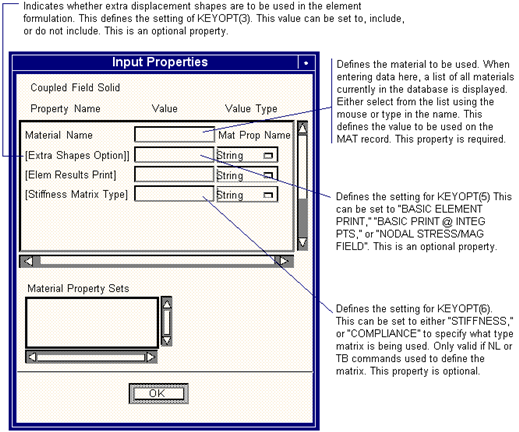

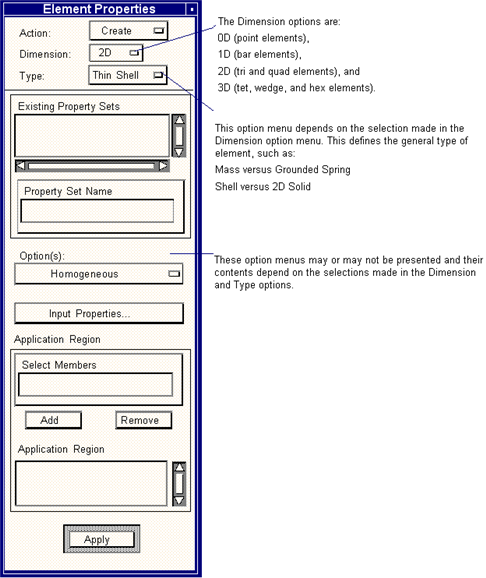
Dimension | Type | Option 1 | Option 2 |
0D | • Mass | • UX,UY • UX,UY,UZ | |
1D | • Beam | ||
• Spar | |||
• Spring/Damper | |||
• Gap | |||
• Cable | |||
• Planar Beam | |||
2D | • Thin Shell | • Laminate | |
• Thick Shell | • Laminate | ||
• 2D Solid | |||
• Membrane | |||
• 2D Coupled Field Solid | |||
3D | • Solid | • Homogeneous | |
• Laminate | |||
• Voltage • Magnetic Flux • UX,UY,UZ • UX,UY,UZ,Temp, Volt,Mag Flux |
Dimension | Type | Option 1 | Option 2 |
0D | • Mass | ||
1D | • Link | • 3D | |
• 2D Link | |||
2D | • Shell | ||
• 2D Solid | • Planar | ||
• Planar • Axisymmetric | |||
• Temperature • Magnetic Flux | |||
3D | • Solid | ||
Analysis Type | Dimension | Type | Option(s) | Topologies |
Structural | 0D | Mass | UX, UY UX, UY, UZ | Point/1 |
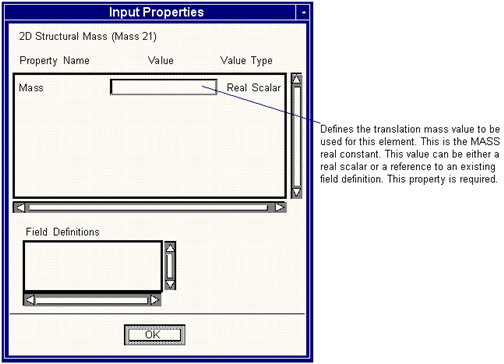
Analysis Type | Dimension | Type | Option(s) | Topologies |
Structural | 0D | Mass | UX, UY, RZ | Point/1 |
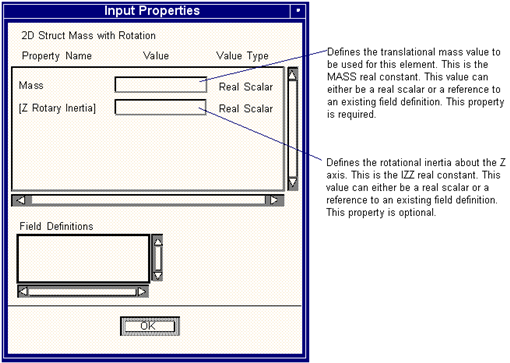
Analysis Type | Dimension | Type | Option(s) | Topologies |
Structural | 0D | Mass | UX, UY, UZ, RX, RY, RZ | Point/1 |
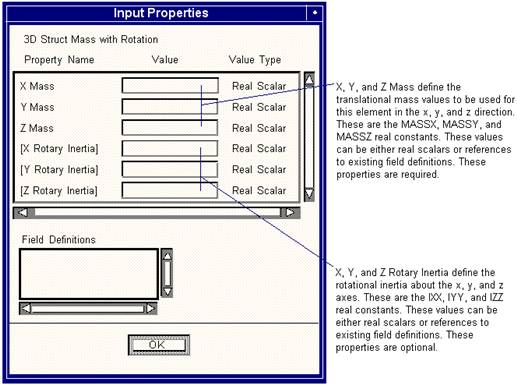
Analysis Type | Dimension | Type | Option(s) | Topologies |
Structural | 1D | Beam | General Section | Bar/2 |
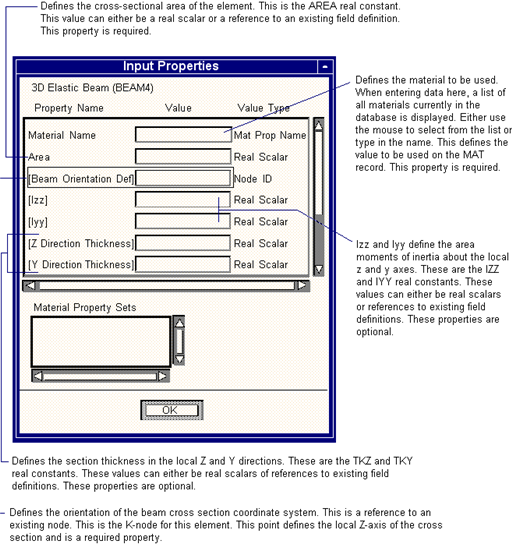
Property Name | Description |
Theta | Theta defines an additional rotation from the beam Orientation data. After the beam orientation is initially established using the Beam Orientation Def data, the Theta rotation is made around the local X-axis to define the final local coordinate system. This is the THETA real constant. This value can either be a real scalar or a reference to an existing field definition. This property is optional. |
Initial Strain | Initial Strain defines the initial strain built into the element. This is the INITIAL STRAIN real constant. This value can either be a real scalar or a reference to an existing field definition. This property is optional. |
Ixx | Ixx defines the torsional moment of inertia about the local x-axis. This is the IXX real constant. This value can either be a real scalar, or a reference to an existing field definition. This property is optional. |
Z Shear Constant Y Shear Constant | Z and Y Shear Constants are the ratios of the actual beam cross-sectional area to the effective area resisting shear deformation in the Z and Y directions. These are the SHEARZ and SHEARY real constants. These values can either be real scalars or references to existing field definitions. These properties are optional. |
Mass Matrix Option | Mass Matrix Option defines the type of mass matrix to be used for these elements. This defines the setting of KEYOPT(1). This value is a character string, which can be set either to consistent, or reduced. This property is optional. However, if it is not defined, consistent will be assumed. |
Node Location Option | Node Location Option defines the setting of KEYOPT(3). This defines how the beam is oriented with respect to the nodes. This value can be set to origin of Y-Z axes, centroid, or shear center. This property is optional. |
Analysis Type | Dimension | Type | Option(s) | Topologies |
Structural | 1D | Beam | Curved Pipe (Elbow) (PIPE18) | Bar/2 |
Note: | Results translation is supported for ANSYS Revision 5 only. |
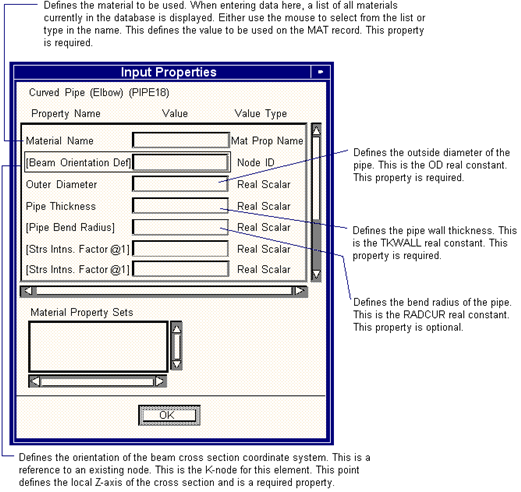
Property Name | Description |
[Strs Intns. Factor @ 1] | Define the stress intensity factor at end I and end J of the beam. These are the SIFI and SIFJ real constants. These properties are optional. |
[Flexibility] | Defines the flexibility factor. This is the FLEX real constant. This property is optional. |
[Internal Fluid Density] | Defines the density of the fluid contained in the pipe. This is the DENSFL real constant. This property is optional. |
[Ext Insulation Density] | Defines the density of the external insulation applied to the pipe. This is the DENSIN real constant. This property is optional. |
[Ext Insulation Thick] | Defines the thickness of the external insulation. This is the TKIN real constant. This property is optional. |
[Corrosion Thick Allow] | Defines the allowable thickness of the corrosion on the pipe. This is the TKCORR real constant. This property is optional. |
[Temp Gradient Defn] | Defines the representation of the temperature gradient. This is KEYOPT(1). The value is a character string which can be set to either “THRU_WALL” or “DIAMETRAL”. The KEYOPT will be set to 0 or 1 respectively. This is an optional property. |
[Pipe Flex Factor Type] | Defines the type of flexibility factor to be used if the FLEX real constant is not specified. This is KEYOPT(3). The value is a character string which may to set to “ANSYS NO PRESS TERM”, “ANSYS WITH PRESS TERM”, or “KARMAN”. These correspond to KEYOPT settings of 0, 1, and 2. This property is optional. |
[Member Results Print] | Specifies if member forces are to be printed. This is KEYOPT(6). The value is a character string which may be set to either “NO MEMBER PRINTOUT” or “PRNT MBR FORCE & MOMENT”. These correspond to KEYOPT settings of 0 and 2. This is an optional property. |
Analysis Type | Dimension | Type | Option(s) | Topologies |
Structural | 1D | Beam | Elastic Straight Pipe (PIPE16) | Bar/2 |
Note: | Results translation is supported for ANSYS Revision 5 only. |
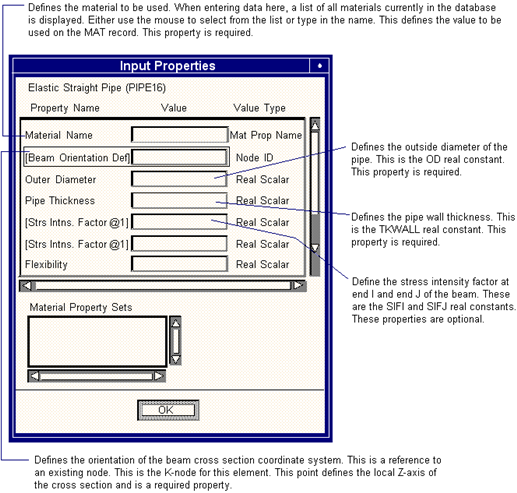
Property Name | Description |
Flexibility | Defines the flexibility factor. This is the FLEX real constant. This property is optional. |
[Internal Fluid Density] | Defines the density of the fluid contained in the pipe. This is the DENSFL real constant. This property is optional. |
[Ext Insulation Density] | Defines the density of the external insulation applied to the pipe. This is the DENSIN real constant. This property is optional. |
[Ext Insulation Thick] | Defines the thickness of the external insulation. This is the TKIN real constant. This property is optional. |
[Corrosion Thick Allow] | Defines the allowable thickness of the corrosion on the pipe. This is the TKCORR real constant. This property is optional. |
[Insulation Surf area] | Defines the surface area of the insulation applied to the pipe. This is the AREAIN real constant. This property is optional. |
[Pipe Wall Mass] | Overrides the pipe wall mass calculation if a value is specified. This is the MWALL real constant. This property is optional. |
[Pipe Axial Stiffness] | Overrides the pipe stiffness calculation if a value is specified. This is the STIFF real constant. This is an optional property. |
[Pipe Rotordynamic Spin] | Defines the value of the rotordynamic spin. This is the SPIN real constant. This property is optional. |
[Temp Gradient Defn] | Defines the representation of the temperature gradient. This is KEYOPT(1). The value is a character string which can be set to either “THRU_WALL” or “DIAMETRAL”. The KEYOPT will be set to 0 or 1 respectively. This is an optional property. |
[Strs Intens Factr Defn] | Defines which stress intensification factor(s) will be used. This is KEYOPT(2). The value is a character string which can be set to “FROM SIFI & SIFJ”, “NODE I TEE JOINT CALC,“, “NODE J TEE JOINT CALC”, or “BOTH NODES TEE JNT CALC”. These correspond to KEYOPT settings of 0, 1, 2, or 3. This is an optional property. |
[Pipe Element Type] | Defines what type of pipe element this will represent. This is KEYOPT(4). The value is a character string which can be set to “STRAIGHT PIPE”, “VALVE”, “REDUCER”, “FLANGE”, “EXPANSION JOINT”, “MITERED BEND”, or “TEE BRANCH”. These correspond to KEYOPT settings of 0. 1. 2. 3. 4. 5. or 6. This is an optional property. |
[Pipe Press Component] | Defines which component(s) of pressure are to be used. This is KEYOPT(5). The value is a character string which may be set to either “NORMAL COMPONENT”, or “FULL PRESSURE”. These correspond to KEYOPT settings of 0 or 1. This is an optional property. |
[Member Results Print] | Specifies if member forces are to be printed. This is KEYOPT(6). The value is a character string which may be set to either “NO MEMBER PRINTOUT” or “PRNT MBR FORCE & MOMENT”. These correspond to KEYOPT settings of 0 and 2. This is an optional property. |
[Gyro Damping Matrix] | Specifies if a gyroscopic damping matrix is to be calculated. This is KEYOPT(7). The value is a character string which may be set to either “NO GYRO DAMP MATRIX”, or “COMPUTE GYRO DAMP MATRIX”. These correspond to KEYOPT settings of 0 or 1. If a gyroscopic damping matrix is to be computed, the SPIN real constant must be greater than zero and DENSFL and DENSIN must be zero. |
Analysis Type | Dimension | Type | Option(s) | Topologies |
Structural | 1D | Beam | Tapered Section | Bar/2 |
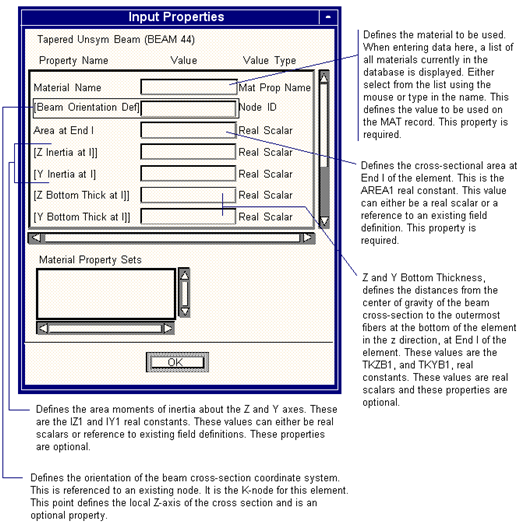
Property Name | Description |
Area at End J | Area at End J defines the cross-sectional area at each end of the element. These are the AREA1 and AREA2 real constants. This value can either be a real scalar or a reference to an existing field definition. This property is required. |
Z Inertia at J Y Inertia at J | Defines the area moments of inertia about the Z and Y axes. These are the IZ2 and IY2 real constants. These values can either be real scalars or reference to existing field definitions. These properties are optional. |
Z Bottom Thickness at J Y Bottom Thickness at J | Z and Y Bottom Thickness defines the distances from the center of gravity of the beam cross-section to the outermost fibers at the bottom of the element in the Z direction at End J. These values are the TKZB2, and TKYB2 real constants. These values are real scalars and are optional properties. |
Torsional Inertia @ I Torsional Inertia @ J | Torsional Inertia defines the torsional inertia values at the ends of the beam. These are IX1 and IX2 real constants. These values can either be real scalars or references to existing field definitions, and are optional properties. |
Nodal Offset at I Nodal Offset at J | Nodal Offset defines the distance from the nodes to the actual center of gravity of the section at each end of the beam. These are the DX1, DY1, DZ1, DX2, DY2, and DZ2 real constants. These values are real vectors, and are optional properties. |
Z Shear Constant Y Shear Constant | Z and Y Shear Constant are the ratios of the actual beam cross-sectional area to the effective and resisting shear deformation in the Z and Y directions. These are the SHEARZ and SHEARY real constants. These values can either be real scalars or references to existing field definitions, and are optional properties. |
Z Top Thickness at I, J Y Top Thickness at I, J | Z and Y Top Thickness defines the distances from the center of gravity of the beam cross-section to the outermost fibers in the positive and negative y and z directions at either end of the element. These values are the TKZT1, TKYT1, TKZT2 and TKYT2 real constants. These values are real scalars and are optional properties. |
Z Dir Shear Area at I, J Y Dir Shear Area at I, J | Z and Y Dir Shear Areas define the shear areas in the y and z directions at either end of the beam. These are the AREAZ1, AREAZ2, and ARESY2 real constants. These values can either be real scalars or references to existing field definitions, and are optional properties. |
Torsional Shear at I Torsional Shear at J | Torsional Shear defines the torsional stress factors at either ends of the beam. These are used in calculating the torsional stresses in the element. These are the TSF1 and TSF2 real constants. These values can either be real scalars or references to existing field definitions, and are optional properties. |
Z Shr Ctr Offset at I, J Y Shr Ctr Offset at I, J | Z and Y Shr Ctr Offset defines the offset from the center of gravity of the section to the shear center. These are the DSCZ1, DSCY1, DSCZ2, and DSCY2 real constants. These values can either be real scalars or references to existing field definitions, and are optional properties. If any of these are defined, KEYOPT(5) will be increased to 3. |
Z Elast Found Stiffness Y Elast Found Stiffness | Z and Y Elast Found Stiffness defines the elastic foundation stiffness in the z and y directions. These are defined as the pressure required to produce a unit normal deflection of the foundation. These are the EFSZ and EFSY real constants. These values can either be real scalars or referenced to existing field definitions, and are optional properties. If either of these properties are defined, KEYOPT(5) will be increased to 3. |
Mass Matrix Options | Mass Matrix Option defines the type of mass matrix to be used for these elements. This defines the setting of KEYOPT(1). This value is a character string, which can be set to either constant, or lumped, and is an optional property. However, if it is not defined, consistent will be assumed. |
End I Releases End J Releases | End Release defines the end release conditions at either end of the element. These define the settings of KEYOPTs (3) and (4). These values are character strings, which can be set to NONE, RX, RY, RZ, RX&RY, or RX&RY&RZ. These properties are optional. |
Analysis Type | Dimension | Type | Option(s) | Topologies |
Structural | 1D | Planar Spar | Bar/2 |
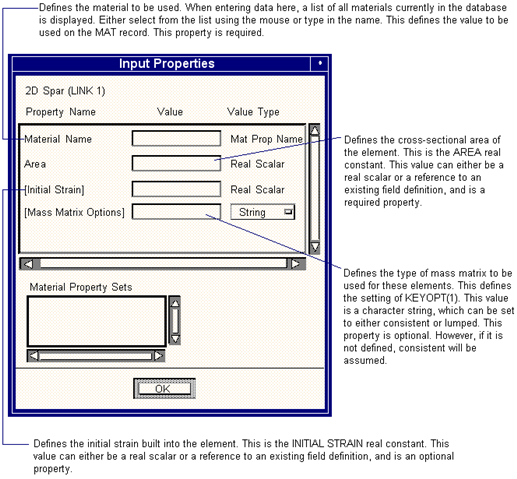
Analysis Type | Dimension | Type | Option(s) | Topologies |
Structural | 1D | Spar | Bar/2 |
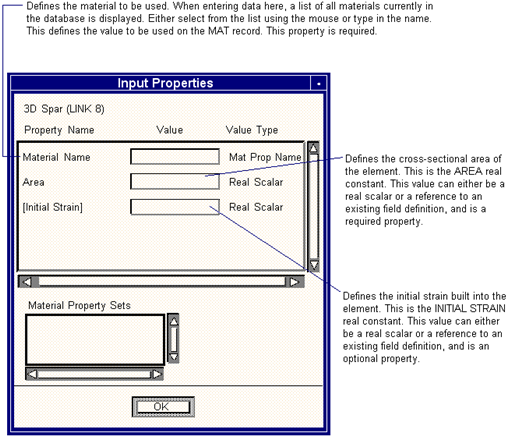
Analysis Type | Dimension | Type | Option(s) | Topologies |
Structural | 1D | Spring/Damper | Standard Formulation | Bar/2 |
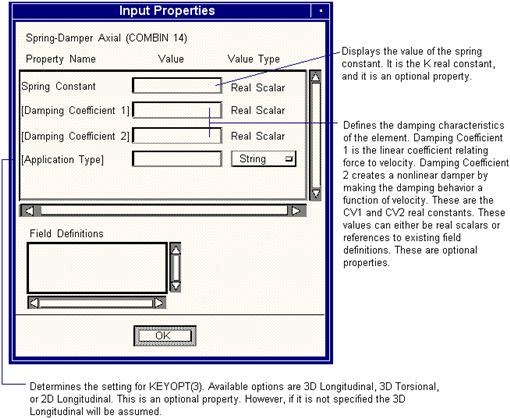
Analysis Type | Dimension | Type | Option(s) | Topologies |
Structural | 1D | Spring/Damper | Fixed Direction | Bar/2 |
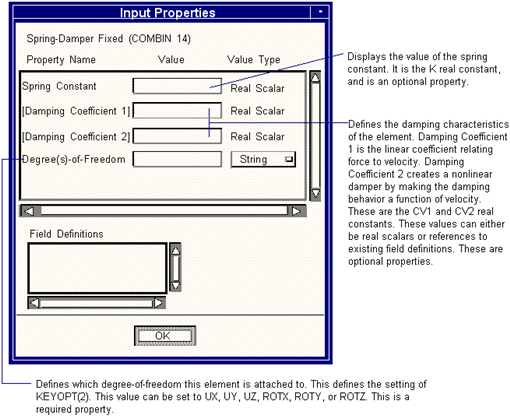
Analysis Type | Dimension | Type | Option(s) | Topologies |
Structural | 1D | Gap | Bar/2 |
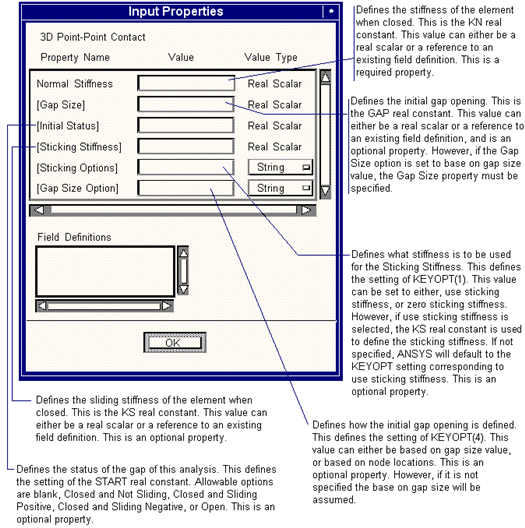
Analysis Type | Dimension | Type | Option(s) | Topologies |
Structural | 1D | Planar Gap | Bar/2 |
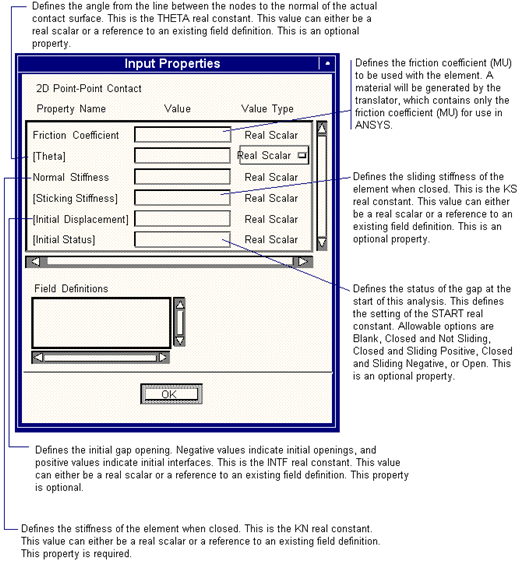
Property Name | Description |
Sticking Options | Defines what stiffness is to be used for the Sticking Stiffness. This defines the setting of KEYOPT(1). This value can either be set to use sticking stiffness or zero sticking stiffness. If use sticking stiffness is selected, the KS real constant is used to define the sticking stiffness. If not specified, ANSYS will default to the KEYOPT setting, corresponding to use sticking stiffness. This is an optional property. |
Gap Size Option | Defines how the initial gap opening is defined. This defines the setting of KEYOPT(4). This value can either be based on gap size value, or based on node locations. This is an optional property. However, if not specified, base on gap size value will be assumed. |
Analysis Type | Dimension | Type | Option(s) | Topologies |
Structural | 1D | Cable | Bar/2 |
Note: | Results translation is supported for ANSYS Revision 5 only. |
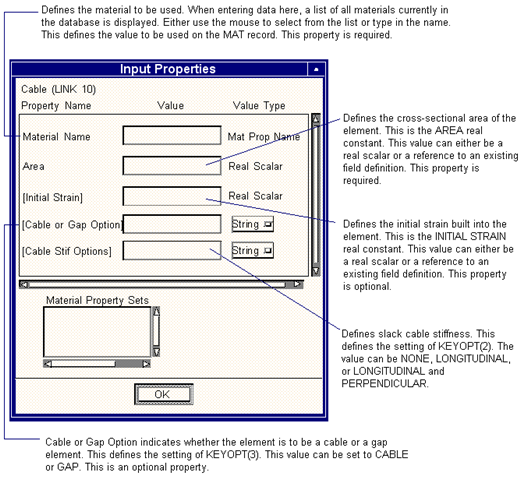
Analysis Type | Dimension | Type | Option(s) | Topologies |
Structural | 1D | Combination | Bar/2 |
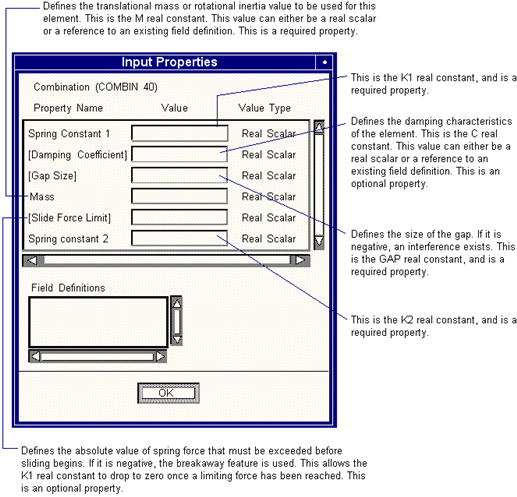
Property Name | Description |
Degree(s)-of-freedom | Defines which degree-of-freedom this element is attached to. This defines the setting of KEYOPTs (2) and (3). This value can be set to ux, uy, uz, rotx, roty, or rotz. This is a required property. |
Mass Distribution | Defines the placement of the element mass values. This defines the setting of KEYOPT(6). This value can be set to, at node I, at node J, or equally distributed. This is an optional property. However, if it is not specified, at node I will be assumed. |
Lock up Option | Removes the gap opening capability once the gap has closed. This defines the setting of KEYOPT(1). Allowable options are: Include, and Do Not Include. This is an optional property. |
Analysis Type | Dimension | Type | Option(s) | Topologies |
Structural | 1D | Axisymmetric Shell | Bar/2 |
Note: | Results translation is supported for ANSYS Revision 5 only. |
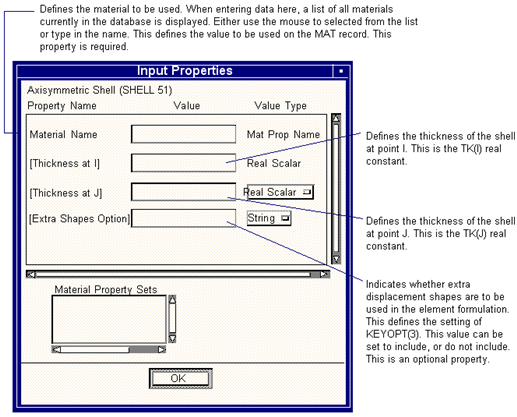
Analysis Type | Dimension | Type | Option(s) | Topologies |
Structural | 1D | Planar Beam | General Section | Bar/2 |
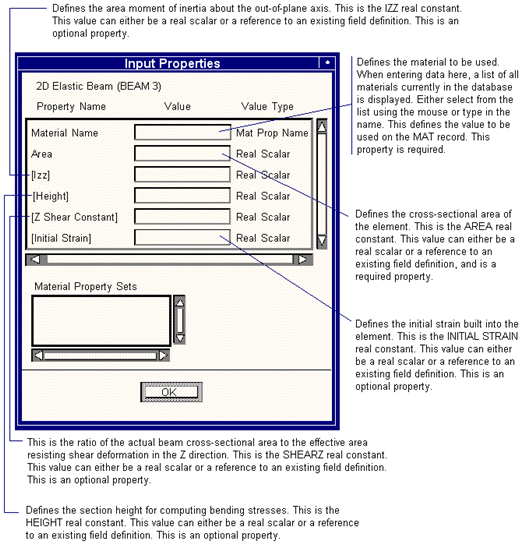
Analysis Type | Dimension | Type | Option(s) | Topologies |
Structural | 1D | Planar Beam | Circular Section | Bar/2 |
Note: | Results translation is supported for ANSYS Revision 5 only. |
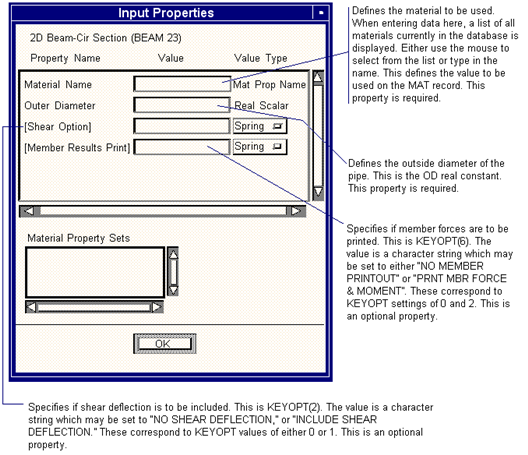
Analysis Type | Dimension | Type | Option(s) | Topologies |
Structural | 1D | Planar Beam | General Plastic Section | Bar/2 |
Note: | Results translation is supported for ANSYS Revision 5 only. |
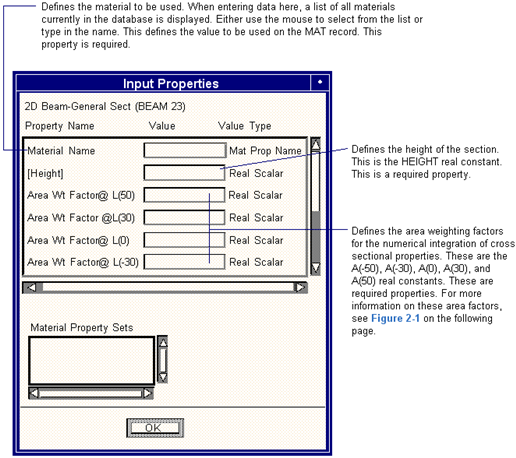
Property Name | Description |
Wt Factor@ L(-50) | |
[Z shear Constant] | Defines the shear deflection constant. This is the SHEARZ real constant. This is an optional property. |
[Shear Option] | Specifies if shear deflection is to be included. This is KEYOPT(2). The value is a character string which may be set to “NO SHEAR DEFLECTION,” or “INCLUDE SHEAR DEFLECTION.” These correspond to KEYOPT values of either 0 or 1. This is an optional property. |
[Member Results Print] | Specifies if member forces are to be printed. This is KEYOPT(6). The value is a character string which may be set to either “NO MEMBER PRINTOUT” or “PRNT MBR FORCE & MOMENT.” These correspond to KEYOPT settings of 0 and 2. This is an optional property. |
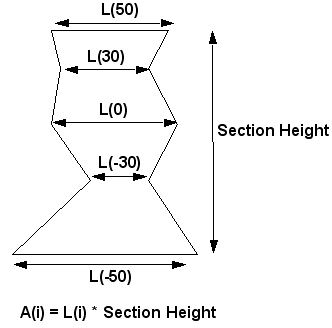
Important: | L(i) are weighting factors for the numerical integration of cross-sectional properties such as area and moment of inertia. For further information on how to define the L(i) see the ANSYS Users Manual, Volume III, Elements and Volume IV, Theory, for the BEAM23 element. |
Analysis Type | Dimension | Type | Option(s) | Topologies |
Structural | 1D | Planar Beam | Pipe Section | Bar/2 |
Note: | Results translation is supported for ANSYS Revision 5 only. |
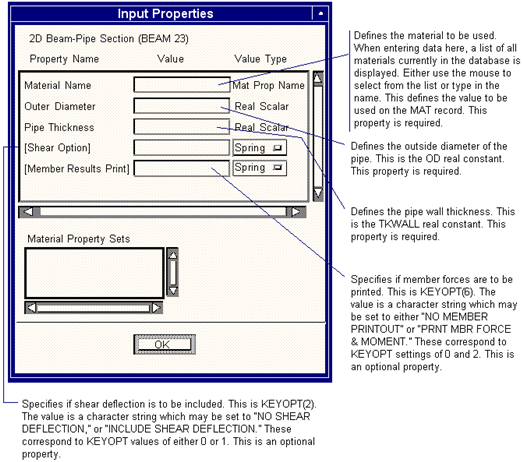
Analysis Type | Dimension | Type | Option(s) | Topologies |
Structural | 1D | Planar Beam | Rectangular Section | Bar/2 |
Note: | Results translation is supported for ANSYS Revision 5 only. |
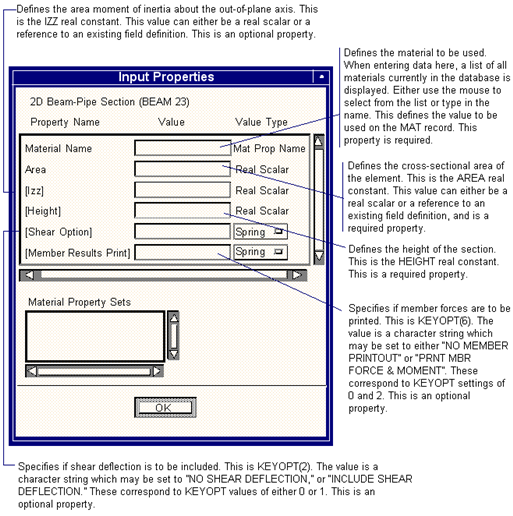
Analysis Type | Dimension | Type | Option(s) | Topologies |
Structural | 1D | Planar Beam | Tapered Section | Bar/2 |
Note: | Results translation is supported for ANSYS Revision 5 only. |
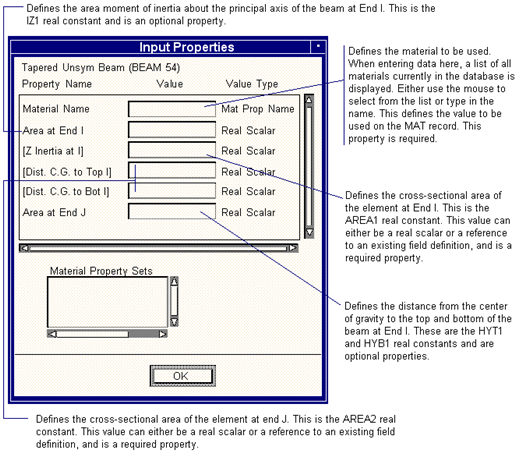
Parameter Name | Description |
Z Inertia at J | Defines the area moment of inertia about the principal axis of the beam at end J. This is the IZ2 real constant and is an optional property. |
Dist. C.G. to Top at J Dist C.G. to Bot at J | Defines the distance from the center of gravity to the top and bottom of the beam at end J. These are the HYT2 and HYB2 real constants and are optional properties. |
Nodal Offset at I Nodal Offset at J | Nodal Offset defines the distance from the nodes to the actual center of gravity of the section at each end of the beam. These are the DX1, DY1, DX2, and DY2 real constants. These values are real vectors, and are optional properties. |
Z Shear Constant | Defines the shear deflection constant. This is the SHEARZ real constant. It is an optional property. |
Shear Area at I Shear Area at J | Defines the shear areas at either end of the beam. These are the AREAS1, and AREAS2 real constants. These values can either be real scalars or references to existing field definitions, and are optional properties. |
Elast Found Stiffness | Defines the elastic foundation stiffness. This is the EFS real constant and is an optional property. |
Analysis Type | Dimension | Type | Option(s) | Topologies |
Structural | 2D | Thin Shell | Homogeneous | Tri/3, Quad/4 |
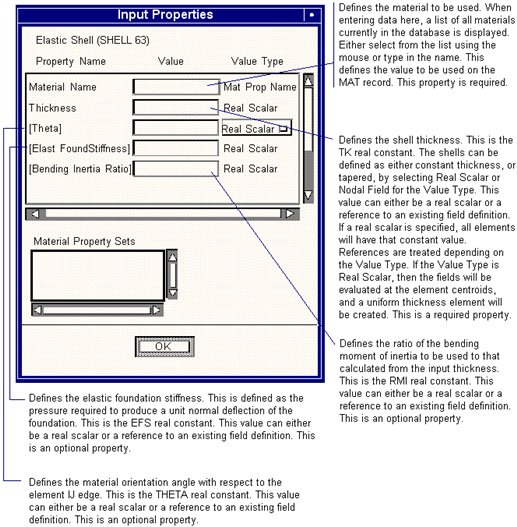
Property Name | Description |
Dist C.G to Top Dist C.G. to Bottom | Defines the section height from the neutral plane to the top of bottom fiber for computing bending stresses. These are the CTOP and CBOT real constants. These values can either be real scalars or references to existing field definitions. These are optional properties. |
Extra Shapes Option | Indicates whether extra displacement shapes are to be used in the element formulation. This defines the setting of KEYOPT(3). This value can be set to, INCLUDE, or DO NOT INCLUDE. This is an optional property. |
Pressure Load Options | Defines how distributed loads are represented within the element. This defines the setting to KEYOPT(6). This can be set to REDUCED or CONSISTENT This is an optional property. However, if it is not specified, REDUCED will be assumed. |
Mass Matrix Options | Defines the type of mass matrix to be used for these elements. This defines the setting of KEYOPT(7). This value is a charter string, which can be set to either CONSISTENT, LUMPED, or REDUCED. This is an optional property. However, if it is not defined, REDUCED will be assumed. |
Analysis Type | Dimension | Type | Option(s) | Topologies |
Structural | 2D | Thin Shell | Laminate | Tri⁄6, Quad⁄8 |
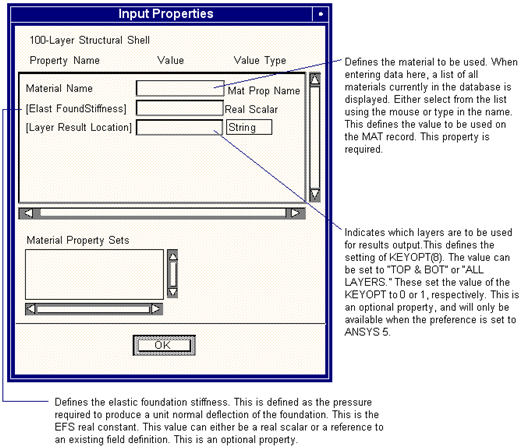
Analysis Type | Dimension | Type | Option(s) | Topologies |
Structural | 2D | Thick Shell | Homogeneous | Tri⁄3, Quad⁄4 Tri⁄6, Quad⁄8 |
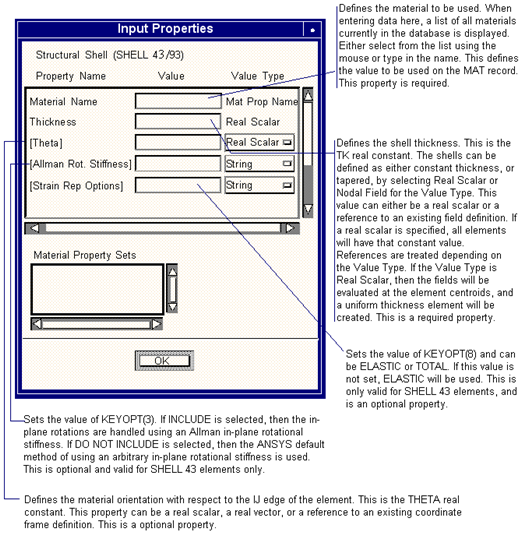
Analysis Type | Dimension | Type | Option(s) | Topologies |
Structural | 2D | Thick Shell | Laminate | Tri⁄6, Quad⁄8 |
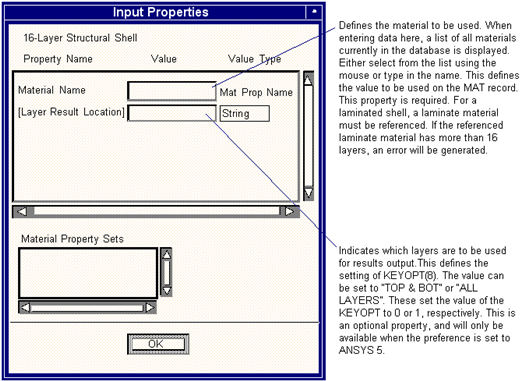
Analysis Type | Dimension | Type | Option(s) | Topologies |
Structural | 2D | Bending Panel | Tri⁄3, Quad⁄4 |
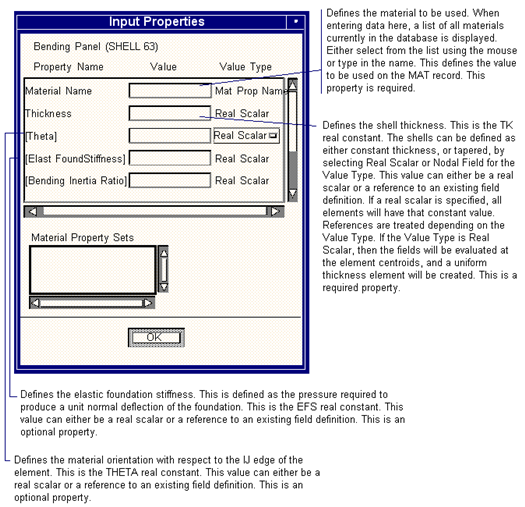
Property Name | Description |
[Bending Inertia Ratio] | Defines the ratio of the bending moment of inertia to be used to that calculated from the input thickness. This is the RMI real constant. This value can either be a real scalar or a reference to an existing field definition. This is an optional property. |
Dist C.G to Top Dist C.G. to Bottom | Defines the section height from the neutral plane to the top of bottom fiber for computing bending stresses. These are the CTOP and CBOT real constants. These values can either be real scalars or references to existing field definitions. These are optional properties. |
Extra Shapes Option | Indicates whether extra displacement shapes are to be used in the element formulation. This defines the setting of KEYOPT(3). This value can be set to INCLUDE, or DO NOT INCLUDE. This is an optional property. |
Pressure Load Options | Defines how distributed loads are represented within the element. This defines the setting to KEYOPT(6). This can be set to REDUCED or CONSISTENT. This is an optional property. However, if it is not specified, REDUCED will be assumed. |
Mass Matrix Options | Defines the type of mass matrix to be used for these elements. This defines the setting of KEYOPT(7). This value is a character string, which can be set to either CONSISTENT or REDUCED. This is an optional property. However, if it is not defined, Reduced will be assumed. |
Analysis Type | Dimension | Type | Option(s) | Topologies |
Structural | 2D | 2D Solid | Plane Strain Axisymmetric | Tri⁄3, Quad⁄4 Tri⁄6, Quad⁄8 |
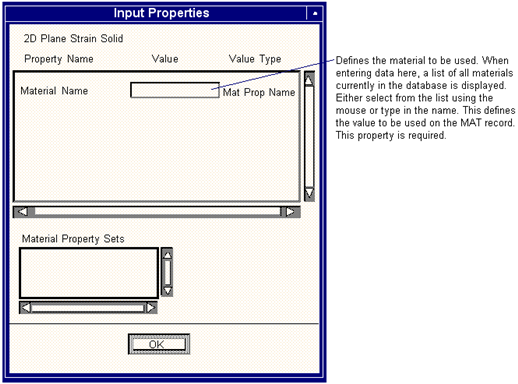
Analysis Type | Dimension | Type | Option(s) | Topologies |
Structural | 2D | 2D Solid | Plane Stress | Tri⁄3, Quad⁄4 Tri⁄6, Quad⁄8 |
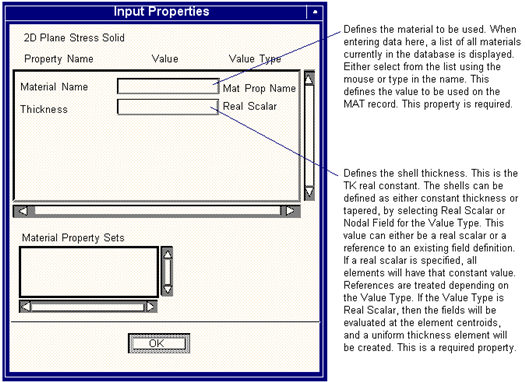
Analysis Type | Dimension | Type | Option(s) | Topologies |
Structural | 2D | Membrane | Tri/3, Quad/4 |
Note: | Results translation is supported for ANSYS Revision 5 only. |
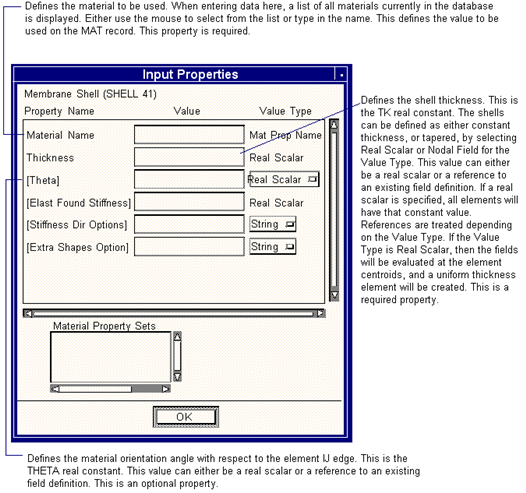
Parameter Name | Description |
Elastic Found Stiffness | Defines the elastic foundation stiffness. This is defined as the pressure required to produce a unit normal deflection of the foundation. This is the EFS real constant. This value can either be a real scalar or a reference to an existing field definition. This is an optional property. |
Stiffness Dir Options | Defines the stiffness behavior of the element to specify if the element has stiffness in both tension and compression or if it has stiffness only in tension and will collapse in compression. This defines the setting of KEYOPT(1). This is a optional property. |
Extra Shapes Option | Indicates whether extra displacement shapes are to be used in the element formulation. This defines the setting of KEYOPT(3). This value can be set to INCLUDE or DO NOT INCLUDE. This is an optional property. |
Analysis Type | Dimension | Type | Option(s) | Topologies |
Structural | 2D | Shear Panel | Quad⁄4 |
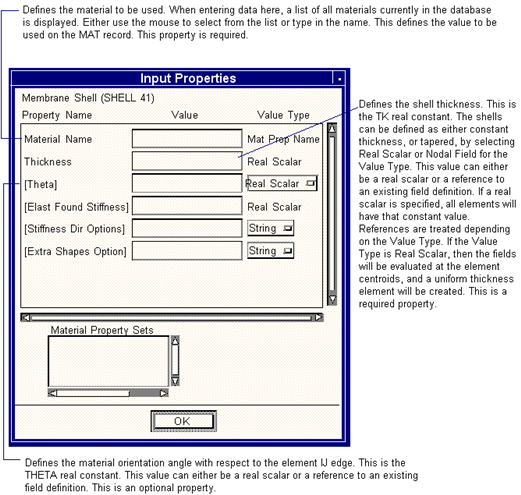
Analysis Type | Dimension | Type | Option(s) | Topologies |
Structural | 2D | Twist Panel | Quad⁄4 |
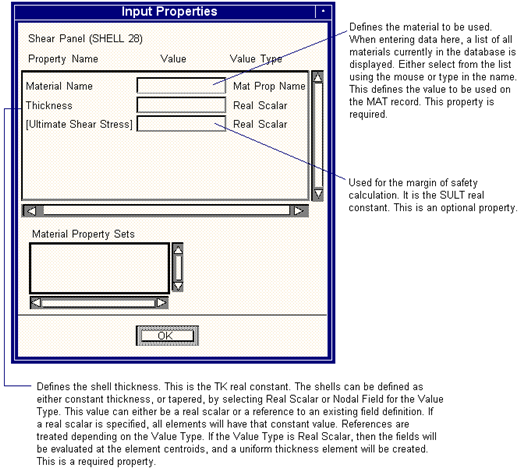
Analysis Type | Dimension | Type | Option 1 | Option 2 | Topologies |
Structural | 2D | 2D Coupled Field Solid | Plane Strain Plane Stress Axisymmetric | Magnetic Flux UX, UY UX,UY,Temp,Mag Flux Volt, Mag Flux UX,UY,Volt | Tri/3, Quad/4 |
Note: | Results translation is supported for ANSYS Revision 5 only. |
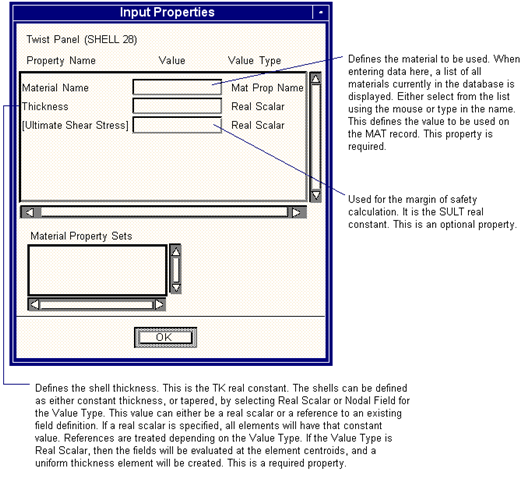
Analysis Type | Dimension | Type | Option(s) | Topologies |
Structural | 3D | Solid | Homogeneous Standard Formulation | Tet⁄4, Wedge⁄6, Hex⁄8, Tet⁄10, Wedge⁄15, Hex⁄20 |
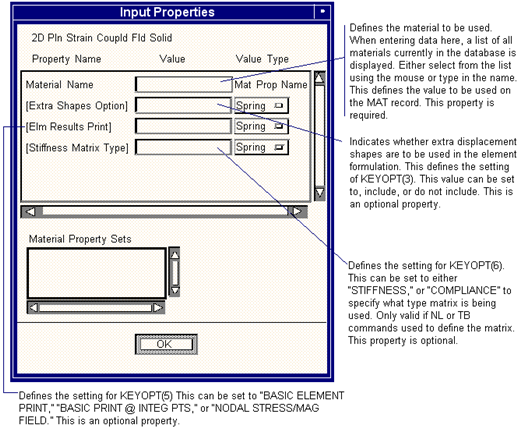
Analysis Type | Dimension | Type | Option(s) | Topologies |
Structural | 3D | Solid | Homogeneous Rotational DOF | Tet/4, Wedge/6, Hex/8 |
Note: | Results translation is supported for ANSYS Revision 5 only. |
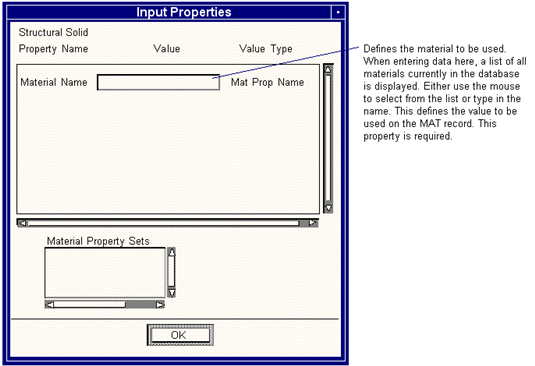
Analysis Type | Dimension | Type | Option(s) | Topologies |
Structural | 3D | Solid | Laminate | Tet⁄4, Wedge⁄6, Hex⁄8 |
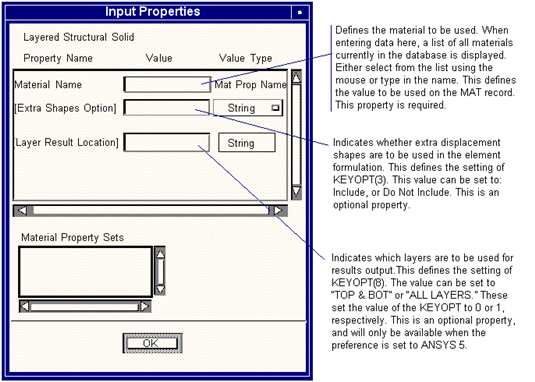
Analysis Type | Dimension | Type | Option(s) | Topologies |
Structural | 2D | Coupled Field Solid | Voltage Magnetic Flux UX,UY,UZ UX,UY,UZ, Temp, Volt,Mag Flux | Tet⁄4, Wedge⁄6, Hex⁄8, Tet⁄10, Wedge⁄15, Hex⁄20 |
Note: | Results translation is supported for ANSYS Revision 5 only. |
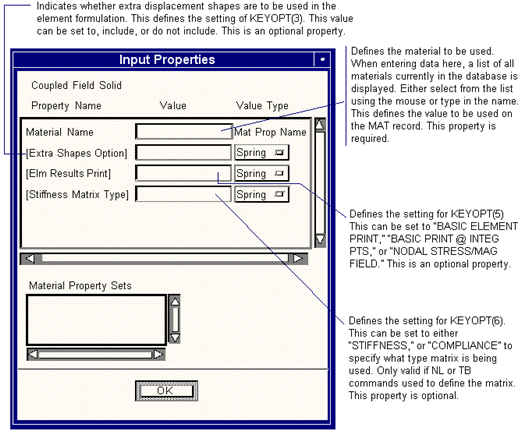
Analysis Type | Dimension | Type | Option(s) | Topologies |
Thermal | 0D | Mass | Point⁄1 |
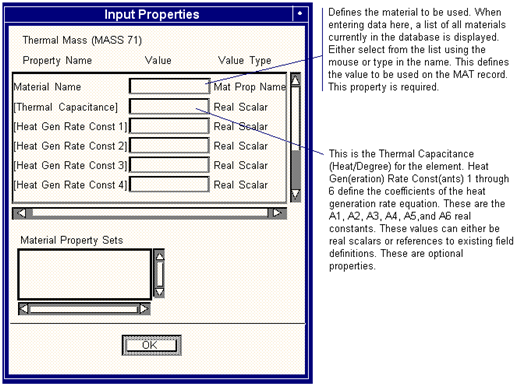
Analysis Type | Dimension | Type | Option 1 | Option 2 | Topologies |
Thermal | 1D | Link | 3D Link | Conduction | Bar⁄2 |
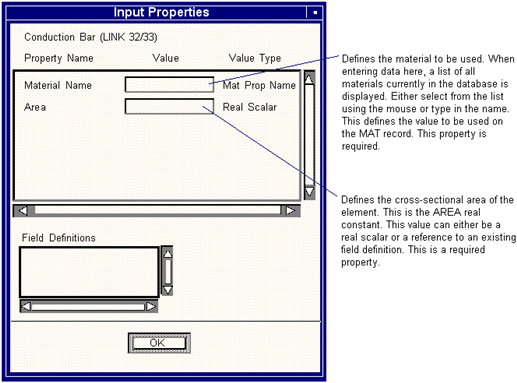
Analysis Type | Dimension | Type | Option 1 | Option 2 | Topologies |
Thermal | 1D | Link | 3D Link | Convection | Bar⁄2 |
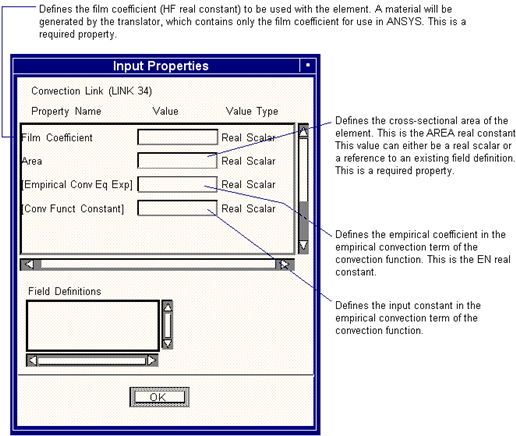
Analysis Type | Dimension | Type | Option 1 | Option 2 | Topologies |
Thermal | 1D | Link | 3D Link | Radiation | Bar⁄2 |
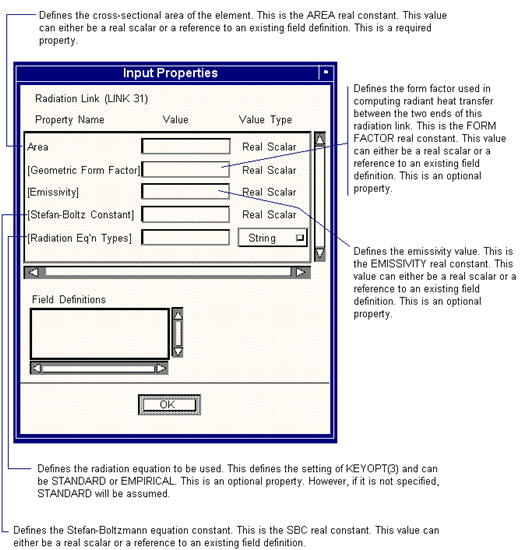
Analysis Type | Dimension | Type | Option(s) | Topologies |
Thermal | 1D | Link | 2D Link | Bar⁄2 |
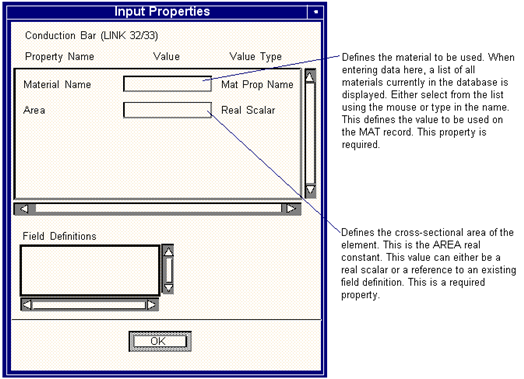
Analysis Type | Dimension | Type | Option(s) | Topologies |
Thermal | 1D | Spring/Damper | Bar⁄2 |
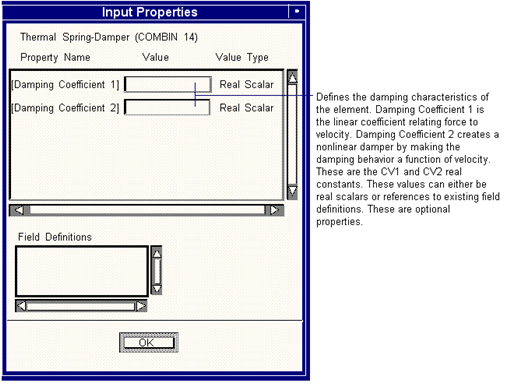
Analysis Type | Dimension | Type | Option(s) | Topologies |
Thermal | 1D | Combination | Bar⁄2 |
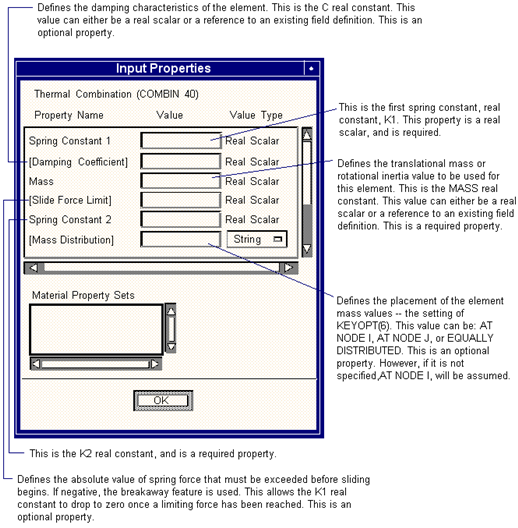
Analysis Type | Dimension | Type | Option(s) | Topologies |
Thermal | 1D | Electric Link | Bar⁄2 |
Note: | Results translation is supported for ANSYS Revision 5 only. |
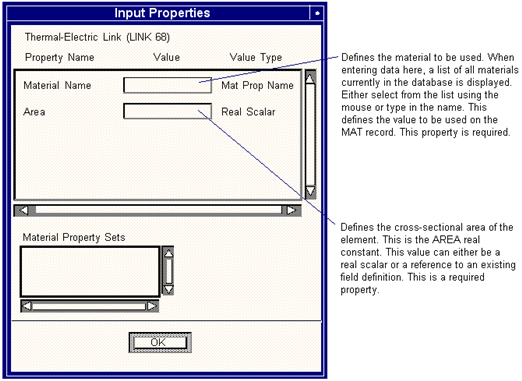
Analysis Type | Dimension | Type | Option(s) | Topologies |
Thermal | 2D | Shell | Tri⁄3, Quad⁄4 |
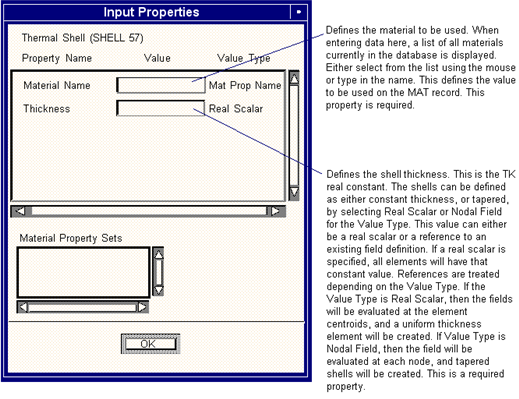
Analysis Type | Dimension | Type | Option(s) | Topologies |
Thermal | 2D | 2D Solid | Planar | Tri⁄3, Quad⁄4, Tri⁄6, Quad⁄8 |
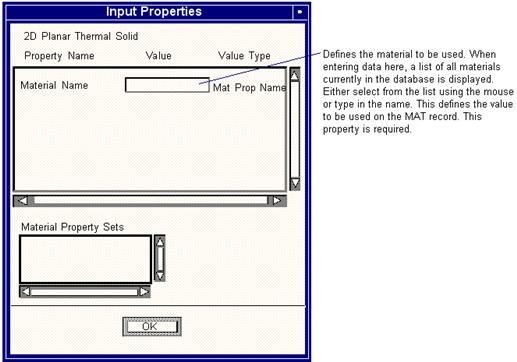
Analysis Type | Dimension | Type | Option(s) | Topologies |
Thermal | 2D | 2D Solid | Axisymmetric | Tri⁄3, Quad⁄4 Tri⁄6, Quad⁄8 |
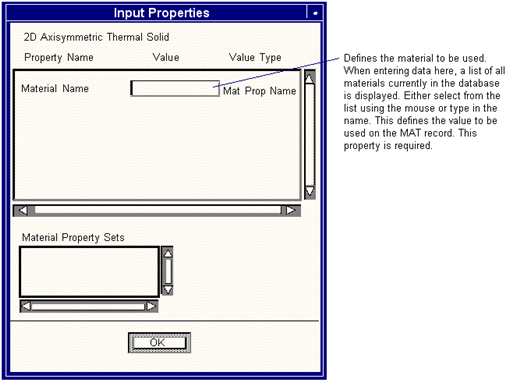
Analysis Type | Dimension | Type | Option(s) | Topologies |
Thermal | 2D | Electric 2D Solid | Planar, Axisymmetric | Tri/3, Quad/4 |
Note: | Results translation is supported for ANSYS Revision 5 only. |
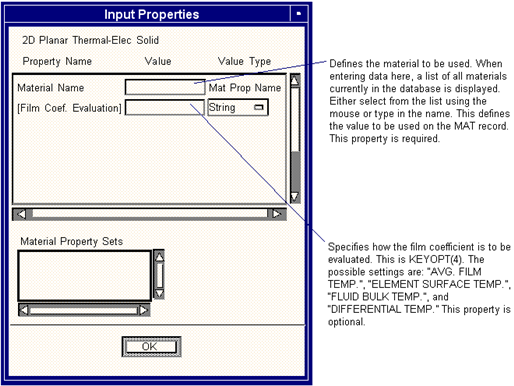
Analysis Type | Dimension | Type | Option(s) | Topologies |
Thermal | 2D | 2D Coupled Field Solid | Temperature Magnetic Flux | Tri/3, Quad/4 |
Note: | Results translation is supported for ANSYS Revision 5 only. |
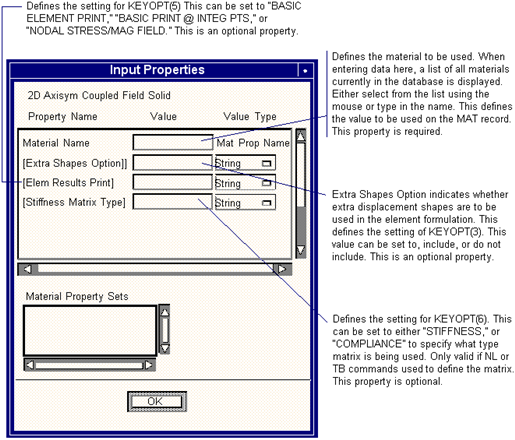
Analysis Type | Dimension | Type | Option(s) | Topologies |
Thermal | 3D | Solid | Tet⁄4, Wedge⁄6, Hex⁄8, Tet⁄10, Wedge⁄15, Hex⁄20 |
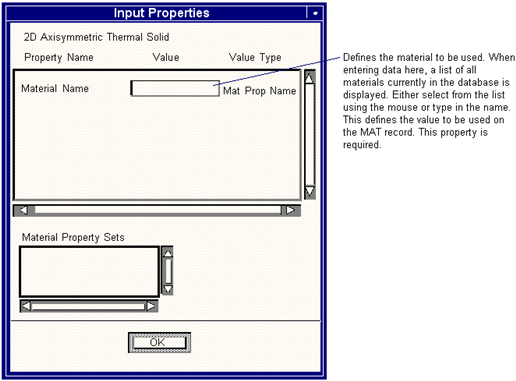
Analysis Type | Dimension | Type | Option(s) | Topologies |
Thermal | 3D | Electric Solid | Tet⁄4, Wedge⁄6, Hex⁄8, Tet⁄10, Wedge⁄15, Hex⁄20 |
Note: | Results translation is supported for ANSYS Revision 5 only. |
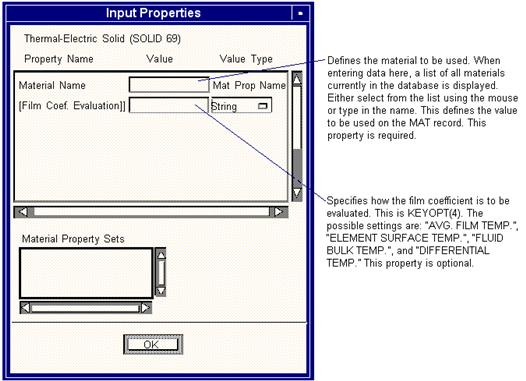
Analysis Type | Dimension | Type | Option(s) | Topologies |
Thermal | 3D | Coupled Field Solid | Temperature, Voltage, Magnetic Flux, UX,UY,UZ,Temp, Volt, Mag Flux Temp, Volt, Mag Flux | Tet⁄4, Wedge⁄6, Hex⁄8, Tet⁄10, Wedge⁄15, Hex⁄20 |
Note: | Results translation is supported for ANSYS Revision 5 only. |
